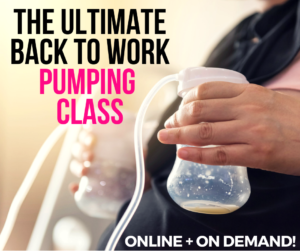CLICK THIS AFFILIATE LINK FOR THE ULTIMATE BACK TO WORK PUMPING CLASS
Having a brand new baby is hard enough. Women returning to work now have to juggle working two jobs. Most men don’t have these challenges after a baby is added to the family. When switching from on-demand breastfeeding to pumping and returning to work, there are some strategies mothers can use to help both with the transition. But going back to work and continuing to breastfeed can be overwhelming. This class from Milkology® is a great start for any new mom, returning to work, who wants to continue to breastfeed.
STRESS CAN AFFECT YOUR BREAST MILK SUPPLY
First the stress of going back to work can negatively affect your milk supply. So what can you do to reduce any unnecessary stress?
- PICK A BED TIME AND STICK TO IT. Routine is essential in regulation breast milk supply and reducing stress. Getting enough rest is also necessary so your body has the energy to keep producing the amount of milk your baby needs.
- WAKE UP A LITTLE EARLIER so that you can pick up your baby and snuggle and breastfeed before getting ready for work. You’ll be more relaxed, and those quiet morning routines are important for both you and your baby to produce that oxytocin and breastmilk. The early morning is when your body has produced significantly more milk than later in the day.
- PUMP AFTER FEEDING. Wait no more than 30 minutes after you breastfeed first thing in the morning to pump again. Your body will get used to this morning pump and will ensure you’ve got plenty of milk to store for use later.
- LET GO OF GUILT as much as you can, for having to go back to work. Make sure that you create a time that is designated in your work day, to pump. Try to pay attention to your body for a few days first, to notice when your boobs feel the fullest so you can get the most out of your pumping. Then continue to stick to the exact same pumping times during your work day.
MAKE SURE YOU HAVE SKIN TO SKIN TIME WITH BABY
- FEED BABY AT THE BREAST. In addition to that first feed when you wake up in the morning, feed your baby at the breast at day care or wherever your baby spends time while you’re at work. Feed baby at drop-off time and/or at pick-up time at the end of your work day.
- EXPOSE YOURSELF TO THE GERMS IN YOUR BABY’S ENVIRONMENT and your body will respond with antibodies to those germs. Your body makes milk specific to your environment. This is called the entero-mammary pathway. This means that your milk contains antibodies that fight the germs in your environment. So, sit at the day care and feed your baby at the breast. Touch as many things in that environment that you can: blankets, toys, crib sheets, even the snotty 3 year old who wants to watch, and anything else your baby can come into contact with.
“SHAKE THE GIRLS”
 That’s what my lactation teacher said all the time because it actually stimulates the breasts and tells them, what’s expected of them. When preparing to pump there are a few things that can help yield a good breastmilk supply:
That’s what my lactation teacher said all the time because it actually stimulates the breasts and tells them, what’s expected of them. When preparing to pump there are a few things that can help yield a good breastmilk supply:
- Shake “the girls”. Massage your breasts, or literally shake them, move them, “wake them up”. This can stimulate the breasts to get ready. My teacher said the women who make the most milk are the ones who are constantly moving “the girls” ie: like a cashier (sliding items across and her arm is moving the breasts every time), a truck driver (vibration of the truck).
- Use warm compresses before pumping.
- Smell the baby’s blanket or clothing.
- Look at photos of your baby.
- Make sure you’ve got a safe, relaxing environment in which to pump. The Patient Protection Act and the ACA requires employers to provide a reasonable break time and a private place free from intrusion from co-workers.
THE BEST EQUIPMENT FOR YOU
Things to look for when buying/renting a breast pump:
- Is the pumping/sucking rhythm adjustable so you can find the most comfortable and effective fit for you?
- Are there different size flanges so you can find one that fits your breasts comfortably.
- Are the pump parts dishwasher safe?
- Is the pump easy to assemble and disassemble?
- Is it covered by insurance?
- Can it be rented? Is it affordable for the length of time you need it?
- Is the pump electric?
- Can it be plugged into a car lighter?
- What noise level does it make when in use? Loud or quiet?
- Can you quickly get parts if needed – overnight or locally?
- What does the warranty cover?
- Is there a toll free number to call for questions or if help is needed?
- Is there an up to date website to refer to?
- Can this pump be used again for another baby? Will it be as efficient after 10-12 months? Does the pressure need to be tested after 6-8 months?
DO NOT USE A CONSUMER PUMP USED BY SOMEONE ELSE. Consumer pumps are designed for single use – one woman, one baby! You can get serious germs including some STD’s by sharing a consumer breast pump. They also do not create as much pressure as a hospital grade pump and will not be as efficient.
In my opinion a hospital grade pump is the best pump if you are going to be busy at work and want an efficient pump that can get the job done in about 10 minutes. That kind of pump would be a double electric pump, for which you would purchase your own personal pump kit. For most people a hospital grade pump is too expensive to buy, But you can find many hospitals and other places that rent them long term at an affordable price.
You go Mommy! You’re doing the best you can do and that is GOOD ENOUGH!











